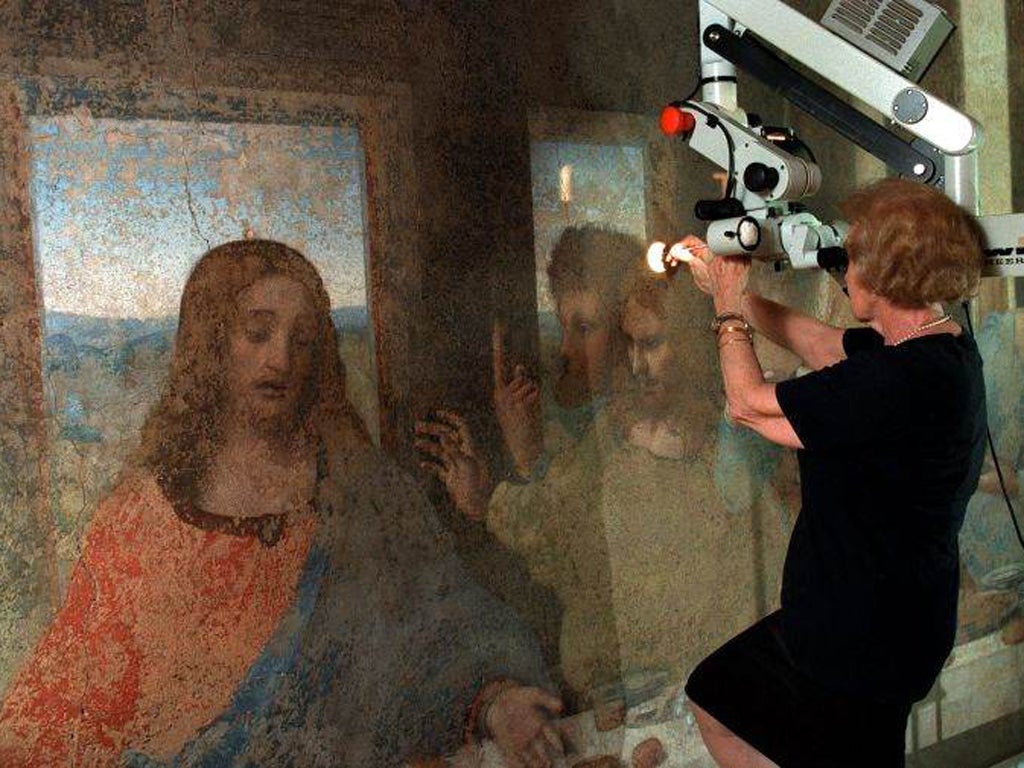A second helping of Leonardo's Last Supper
Attempts by scientists to preserve the disintegrating mural appear to be paying off

Leonardo da Vinci's Last Supper, perhaps the most celebrated painting in the history of Western art, has been slowly disintegrating before our eyes, its demise hastened by the pollution from the clogged city streets of its home city Milan.
But hi-tech attempts to stop the rot and save the fragile masterpiece appear to be finally paying off.
Italian officials called in civil engineering specialists at the University of Southern California two years ago to provide the precious painting with its own micro-climate. The experts installed a sophisticated heating, ventilation, and air conditioning system, with the key aim of reducing the fragile mural's exposure to acid pollutants in the air.
Next month, the engineers, led by Professor Constantinos Sioutas, will reveal how the complex system has achieved a "spectacular" reduction in the amount of damaging pollution in the immediate vicinity of the art work, which Leonardo painted on the refectory wall of the city's Santa Maria delle Grazie Church, in the final decade of the 15th century.
Commenting on the system's effectiveness this week, Professor Sioutas said: "It's a spectacular reduction. It is, frankly, very impressive." The full results will be presented in Milan in December. But a summary has appeared in the latest issue of the journal Environmental Science and Technology.
The vital protection for the painting has not come a moment too soon. For five centuries the work has captivated observers with the unprecedented realism in which it depicts the moment Christ reveals to his 12 Apostles that one of them will betray him. But almost from the time it was completed, at the behest of Leonardo's patron, Duke Ludovico Sforza, the delicate painting has been in decline. This was hastened by centuries of damage and poor maintenance, and even inept attempts at restoration – one 19th-century restorer seriously damaged the centre of the painting by using techniques appropriate for a fresco, a painting done on wet plaster. The Last Supper, which was painted on a dry wall, is really a mural.
The Renaissance masterpiece has had to suffer more recent indignities. Three years ago the controversial film-maker Peter Greenaway attempted a few improvements of his own by projecting a light show on the painting, despite the misgivings of many art experts. The art critic Brian Sewell said authorities were "out of their minds" to permit the show, given the painting's extreme fragility.
But with Milan's notorious traffic pollution dealt with, the most serious threat to The Last Supper probably now comes from the inexhaustible public demand to see it, particularly after the popular novelist Dan Brown gave the painting a key part in his mega-selling thriller The Da Vinci Code.
Experts warn that chemicals from the skin of visitors to the church were appearing in significant quantities around the painting – even with visitor access to the painting strictly regulated; only a handful of patrons are allowed into the church via an airlock-style chamber at any given time, and they are only allowed to stay for 15 minutes at a time.
But even small amounts of airborne lipids from visitors' skin can combine with dust in the air and, if they come in contact with the painting, soil it, said another of the USC team, Nancy Daher.
Subscribe to Independent Premium to bookmark this article
Want to bookmark your favourite articles and stories to read or reference later? Start your Independent Premium subscription today.

Join our commenting forum
Join thought-provoking conversations, follow other Independent readers and see their replies